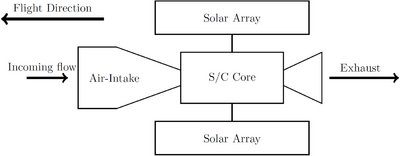Engineering:Air-breathing electric propulsion
Air-breathing electric propulsion, or atmosphere-breathing electric propulsion, is a propulsion technology for spacecraft, which could allow thrust generation in low orbits without the need of on-board propellant, by using residual gases in the atmosphere as propellant. Air-breathing electric propulsion could make a new class of long-lived, low-orbiting missions feasible. The concept is currently investigated by the European Space Agency[1] and the EU-Funded DISCOVERER project.[2] Current state-of-the-art conventional electric thrusters cannot maintain flight at low altitudes for any times longer than about 2 years,[3] because of the limitation in propellant storage and in the amount of thrust generated, which force the spacecraft's orbit to decay. The European Space Agency officially announced the first successful RAM-EP prototype on-ground demonstration in March 2018.[4]
Principle of operation
An ABEP is basically composed by an intake and an electric thruster: rarefied gases which are responsible for drag in LEO and VLEO (Low and Very Low Earth Orbit), are used as the propellant.[5][6] This technology would ideally allow S/Cs to fly at very low orbits without the need of on-board propellant, allowing longer time missions in a new section of atmosphere’s altitudes. This advantage makes the technology of interest for scientific missions as well as military and civil surveillance services.
A special intake will be used to collect the gas molecules and direct them to the thruster while maintaining their velocity and pressure. The molecules will then be ionized by the thruster and expelled from the nozzle at a very high velocity, generating thrust. The electric power needed can be provided by the same power subsystems developed for the actual electric propulsion systems, likely a combination of solar arrays and batteries, though other kind of electric power subsystems can be considered. An ABEP could extend the lifetime of satellites in LEO and VLEO by compensating the atmospheric drag during their time of operation. The optimal altitude for an Earth-orbiting ABEP is approximately 200 km.[7] This technology could also be utilized on other planets with an atmosphere and sufficient solar irradiation, such as Mars and Venus.
Concepts and testing
ESA's RAM-EP, designed and developed by SITAEL in Italy, was first tested in laboratory in May 2017.[8][9][10]
Busek Co. Inc. in the US patented their concept of an Air Breathing Hall Effect Thruster (ABHET) in 2004,[11] and with funding from the NASA Institute for Advanced Concepts, started in 2011 a feasibility study that would be applied to Mars (Mars-ABHET or MABHET), where the system would breath and ionize atmospheric carbon dioxide.[12] The MABHET concept is based on the same general principles as JAXA's Air Breathing Ion Engine (ABIE) or ESA's RAM-EP.[13]
References
- ↑ "World-first firing of air-breathing electric thruster". Space Engineering & Technology (European Space Agency). 5 March 2018. http://www.esa.int/Our_Activities/Space_Engineering_Technology/World-first_firing_of_air-breathing_electric_thruster. Retrieved 7 March 2018.
- ↑ "Home - Discoverer". https://discoverer.space/. Retrieved 28 March 2018.
- ↑ D. DiCara, J. G. del Amo, A. Santovincenzo, B. C. Dominguez, M. Arcioni, A. Caldwell, and I. Roma, “RAM electric propulsion for low earth orbit operation: an ESA study”, 30th IEPC, IEPC-2007-162, 2007.
- ↑ "World-first firing of air-breathing electric thruster". Space Engineering & Technology (European Space Agency). 5 March 2018. http://www.esa.int/Our_Activities/Space_Engineering_Technology/World-first_firing_of_air-breathing_electric_thruster. Retrieved 7 March 2018.
- ↑ T. Schönherr, K. Komurasaki, F. Romano, B. Massuti-Ballester, and G. Herdrich, Analysis of Atmosphere-Breathing Electric Propulsion, IEEE Transactions on Plasma Science, vol.43, no.1, January 2015
- ↑ Romano, Francesco; Massuti-Ballester, Bartomeu; Binder, Tilman; Herdrich, Georg; Schönherr, Tony (2018). "System analysis and test-bed for an atmosphere-breathing electric propulsion system using an inductive plasma thruster". Acta Astronautica. doi:10.1016/j.actaastro.2018.03.031. Bibcode: 2018AcAau.147..114R. https://www.sciencedirect.com/science/article/pii/S009457651730406X?via%3Dihub.
- ↑ B. Conley, Utilization of Ambient Gas as a Propellant for Low Earth Orbit Electric Propulsion, MIT 1995
- ↑ [1]
- ↑ World-first firing of air-breathing electric thruster. ESA. 5 March 2018.
- ↑ SITAEL space team successfully announces world premiere RAM-EP laboratory demonstration. SITAEL.
- ↑ V. Hruby, B. Pote, T. Brogan, K. Hohman, J. J. Szabo, Jr., and P. S. Rostler. "Air breathing electrically powered Hall effect thruster". Busek Company, Inc., Natick, MA, USA, Patent US 6,834,492 B2, Dec. 2004. https://patents.google.com/patent/US6834492.
- ↑ K. Hohman et al.. "Atmospheric Breathing Electric Thruster for Planetary Exploration". NIAC Spring Symposium, March 27–29, 2012.. https://www.nasa.gov/pdf/636899main_Hohman_Presentation.pdf.
- ↑ AEP (Air-breathing Electric Propulsion) development for future low-orbit space flight. EO Portal. ESA.


